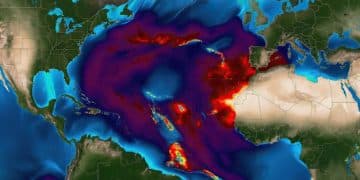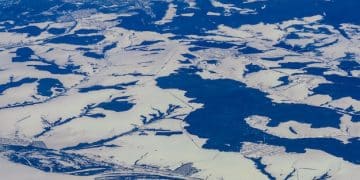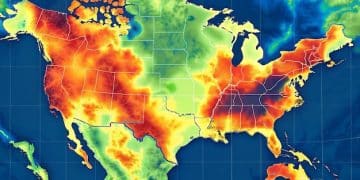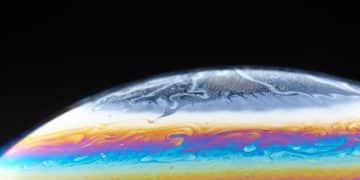Climate Change & Extreme Weather: A Scientific Update
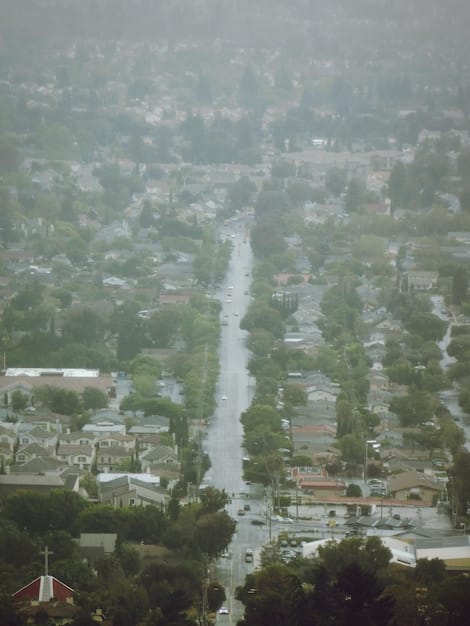
The scientific consensus unequivocally links climate change to the rising intensity and frequency of extreme weather events, driven by anthropogenic greenhouse gas emissions that warm the planet and disrupt atmospheric and oceanic patterns, leading to more severe and impactful phenomena globally.
Understanding The Role of Climate Change in Intensifying Extreme Weather Events: A Scientific Update is no longer just an academic pursuit; it is a critical necessity for communities worldwide. As reports of unprecedented heatwaves, ferocious storms, and devastating floods dominate headlines, it becomes crucial to delve into the scientific underpinnings that connect our changing climate to these escalating meteorological phenomena.
The Unequivocal Link: Climate Change and Weather Extremes
The relationship between climate change and extreme weather isn’t a theory; it’s an observable, scientifically documented reality. Global temperatures have risen significantly over the past century, primarily due to human activities, particularly the burning of fossil fuels. This warming has profound implications for the Earth’s weather systems, altering fundamental patterns and increasing the likelihood of more intense and frequent extreme events.
Scientists use advanced climate models and historical data to identify trends and attribute specific events, or aspects of them, to climate change. This field, known as attribution science, has matured considerably, allowing researchers to quantify the extent to which human-induced warming makes certain events more probable or severe.
Rising Global Temperatures and Atmospheric Energy
One of the most direct links is the increase in global temperatures. A warmer atmosphere holds more moisture, leading to heavier precipitation events. It also provides more energy for storm systems, potentially fueling stronger hurricanes and intensified thunderstorms.
- Enhanced Water Cycle: Higher temperatures increase evaporation from oceans and land, injecting more water vapor into the atmosphere. This increased moisture content can then lead to more intense rainfall and snowfall, contributing to flooding.
- Heat Stress: Warmer baseline temperatures mean that heatwaves start from a higher point and can reach more extreme peaks, making them more dangerous and prolonged.
- Arctic Amplification: The Arctic is warming at a rate two to three times faster than the global average, a phenomenon known as Arctic amplification. This rapid warming can influence atmospheric circulation patterns, potentially leading to more persistent weather patterns and extreme cold outbreaks in mid-latitudes, even as the planet warms overall.
The energy balance of the Earth is being profoundly altered. Excess heat trapped by greenhouse gases isn’t just warming the air; it’s also warming the oceans, melting glaciers, and shifting ocean currents, all of which are critical drivers of weather and climate.
This section underscores that the scientific community views the connection between climate change and extreme weather as robust and well-established, supported by extensive data and sophisticated modeling techniques.
Shifting Precipitation Patterns and Hydrological Extremes
Climate change is fundamentally altering the global water cycle, leading to more pronounced and dangerous hydrological extremes. This includes not only more intense rainfall leading to floods but also prolonged droughts in other regions, creating a complex and challenging scenario for water management and disaster preparedness.
The principle is straightforward: a warmer atmosphere can hold approximately 7% more moisture for every 1°C increase in temperature. This means that when atmospheric conditions are right for precipitation, there’s simply more water available to fall.
Increased Frequency and Intensity of Heavy Rainfall
Across many parts of the world, heavy precipitation events are becoming more common and more intense. This has significant implications for urban and rural areas, overwhelming drainage systems and leading to flash floods and riverine flooding.
- Urban Flooding: Cities, with large areas of impermeable surfaces, are particularly vulnerable to intense downpours, leading to water accumulation and disruption.
- Agricultural Impacts: Both too much and too little water can decimate crops, impacting food security and the livelihoods of farmers.
- Infrastructure Strain: Bridges, roads, and other essential infrastructure are not always designed to withstand the increased stress of more frequent and severe flooding.
Conversely, some regions are experiencing longer and more severe dry spells. Droughts are exacerbated by higher temperatures, which increase evaporation from soil and reservoirs, and by changes in atmospheric circulation that steer storm tracks away from affected regions.
The dual impact of increased floods and droughts highlights the disruptive nature of climate change on the planet’s water resources, demanding comprehensive adaptation strategies.
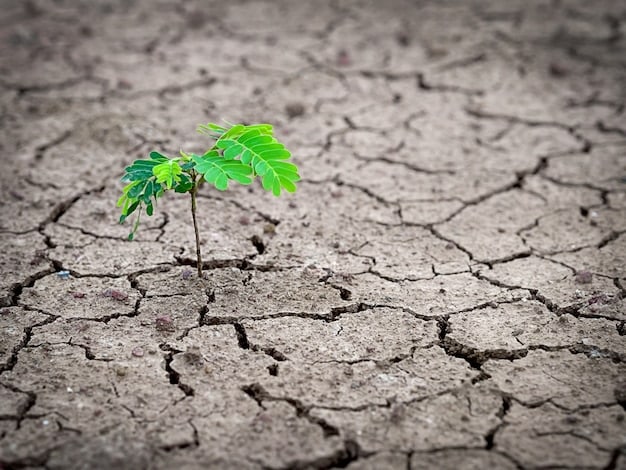
Tropical Cyclones: Intensity, Rainfall, and Slowing Speed
The relationship between climate change and tropical cyclones (hurricanes, typhoons) is nuanced but points towards a future with more destructive storms. While the total number of cyclones globally might not increase, there are clear indications of changes in their characteristics.
The observational record shows that the intensity of the strongest tropical cyclones is increasing. This means that when a storm does form, it is more likely to reach higher categories, bringing more destructive winds and storm surge. This is linked to warmer ocean temperatures, which provide the energy source for these powerful systems.
Warmer Oceans: Fuel for Stronger Storms
Ocean heat content has been steadily rising, particularly in the upper layers. This provides the necessary thermal energy for tropical cyclones to form, intensify, and sustain themselves for longer periods. Warmer waters also contribute to higher sea levels, which exacerbates the impacts of storm surge.
- Increased Category 4 and 5 Storms: There is an observable trend towards a greater proportion of the most powerful storms, posing severe threats to coastal communities.
- Rapid Intensification: Storms are increasingly undergoing rapid intensification, where their wind speeds increase drastically over a short period, making forecasting and preparedness more challenging.
- Slowing Forward Speed: Some research suggests that tropical cyclones are slowing down their forward speed, meaning they linger over an area for longer, dumping more rain and prolonging exposure to destructive winds.
The link between climate change and tropical cyclones extends beyond just intensity. Warmer air holds more moisture, so even if wind speeds aren’t record-breaking, storms are bringing significantly more rainfall. This “rain bomb” effect can cause widespread inland flooding, even far from the coast.
The combination of stronger winds, higher storm surges due to sea level rise, and unprecedented rainfall makes each individual tropical cyclone event potentially more devastating in a warming world.
Heatwaves and Wildfires: A Vicious Cycle
The escalating frequency and intensity of heatwaves are among the most direct and easily attributable impacts of climate change. These prolonged periods of extreme heat not only pose immediate health risks but also create conditions ripe for devastating wildfires, completing a dangerous feedback loop.
Globally, average temperatures have risen, establishing a higher baseline from which heatwaves emerge. This means that a “normal” hot summer day can now reach temperatures that were once considered extreme. Moreover, atmospheric circulation changes can lead to “heat domes” or persistent high-pressure systems that trap hot air over regions for extended periods.
Exacerbated Wildfire Conditions
Extreme heat dries out vegetation, turning forests, grasslands, and agricultural areas into tinderboxes. When combined with strong winds and lightning strikes (which can also be influenced by warming climates), the conditions for large, uncontrollable wildfires become highly favorable.
- Longer Fire Seasons: Many regions are experiencing extended periods when conditions are ripe for wildfires, prolonging the threat.
- Increased Burned Area: The combination of hotter, drier conditions and increased fuel availability is leading to larger and more destructive fires.
- Smoke and Air Quality: Wildfires release massive amounts of smoke, impacting air quality across vast distances, with significant health implications.
The relationship is cyclical: climate change drives more intense heatwaves, which in turn fuel more severe wildfires. These fires then release significant amounts of greenhouse gases into the atmosphere, contributing further to climate change. This positive feedback loop underscores the urgency of addressing both the causes and consequences of warming.
The human cost of these events is severe, ranging from heat-related illnesses and fatalities to displacement and property destruction caused by wildfires. Adaptation strategies and mitigation efforts are paramount in breaking this dangerous cycle.
Cryosphere in Retreat: Glaciers, Ice Sheets, and Sea Level Rise
The Earth’s cryosphere – the frozen parts of our planet – is experiencing rapid and widespread melting due to rising global temperatures. This retreat of glaciers, ice sheets, and sea ice has profound implications for global sea levels and regional weather patterns, further intensifying extreme events.
The melting of ice on land, specifically glaciers and the vast ice sheets of Greenland and Antarctica, is the largest contributor to global sea level rise. As more land-based ice melts and flows into the oceans, global mean sea levels continue to climb. This rise isn’t uniform, but its effects are universally concerning for coastal communities.
Coastal Vulnerability and Storm Surge
Higher sea levels mean that coastal communities are more vulnerable to storm surges during hurricanes and other coastal storms. Even relatively weak storms can now cause significant flooding, as the baseline water level is higher. This increases the destructive potential of all coastal weather events.
- Increased Flooding: Coastal areas face more frequent and severe inundation from high tides and storm events.
- Erosion: Beaches and coastlines are eroding at accelerated rates, diminishing natural protections against storms.
- Saltwater Intrusion: Rising sea levels can also lead to saltwater intrusion into freshwater aquifers, impacting drinking water supplies and agricultural land.
The melting of sea ice, while not directly contributing to sea level rise (as it’s already in the water), has significant implications for albedo (reflectivity) and Arctic amplification. Less reflective ice means more solar radiation is absorbed by the ocean, leading to further warming and feedback loops that accelerate Arctic warming.
The retreat of the cryosphere serves as a stark visual indicator of global warming and highlights another critical pathway through which climate change intensifies the impacts of extreme weather, particularly in vulnerable coastal regions.
Future Projections and Adaptation Strategies
Looking ahead, climate models consistently project that the trends of intensifying extreme weather events will continue and likely worsen without substantial global action to reduce greenhouse gas emissions. The scientific community is clear: further warming equates to more severe impacts.
Projections indicate that heatwaves will become even more common, intense, and prolonged. Precipitation extremes are expected to continue their increases, leading to more frequent and severe flooding in many regions, while others face persistent droughts. The most powerful tropical cyclones are also projected to become even stronger and wetter.
The Imperative of Mitigation and Adaptation
Addressing these future challenges requires a dual approach: mitigation and adaptation. Mitigation involves reducing greenhouse gas emissions to slow or halt global warming. This includes transitioning to renewable energy, improving energy efficiency, and protecting carbon sinks like forests.
- Global Cooperation: International agreements and concerted efforts are vital for achieving meaningful emissions reductions.
- Technological Innovation: Advancements in clean energy and sustainable practices can accelerate the transition away from fossil fuels.
- Policy Frameworks: Strong governmental policies are needed to incentivize green technologies and disincentivize high-emission activities.
Adaptation, on the other hand, focuses on preparing for and responding to the impacts that are already unavoidable or will occur in the future. This includes building more resilient infrastructure, developing early warning systems for extreme weather, and implementing sustainable water management practices.
Future projections underscore the urgency of acting now. While the scale of the challenge is immense, a combination of ambitious mitigation and robust adaptation strategies offers the best path forward to minimize the intensifying impacts of extreme weather events in a warming world.
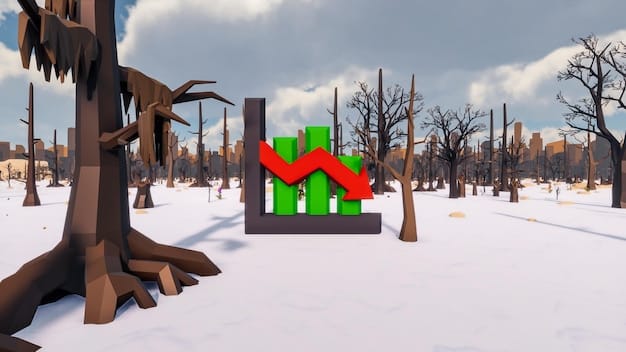
Attribution Science: Linking Individual Events to Climate Change
Attribution science has emerged as a crucial field that bridges the gap between general climate change trends and specific extreme weather events. It allows scientists to determine how much climate change has influenced the probability or intensity of an individual heatwave, flood, or drought, providing concrete evidence of its real-world impacts.
The core methodology involves comparing the likelihood of an extreme weather event occurring in the current climate (with human-induced warming) versus a hypothetical climate without human influence. This typically involves running climate models with and without anthropogenic greenhouse gas emissions.
Sophisticated Methodologies and Growing Certainty
Early attribution studies were cautious, but as models have improved and observational data sets have grown, the confidence in attributing specific events, especially heatwaves, to climate change has risen significantly. For some heatwaves, scientists have concluded that they would have been virtually impossible without human-induced warming.
- Event Selection: Scientists select events that are well-observed and where the physical mechanisms linking them to climate change are understood.
- Model Simulations: Numerous climate model simulations are run to compare the event’s likelihood and characteristics under different climate scenarios.
- Statistical Analysis: Statistical methods are used to quantify the increased probability or intensity due to climate change.
While attributing every nuance of every event solely to climate change is complex, attribution science provides powerful evidence of a discernible human fingerprint on the increasing severity of weather extremes. It helps to move the conversation from “is it happening?” to “how much is it impacting us?”
This scientific advancement is vital for informing policy decisions, risk assessments, and legal actions related to climate change impacts, making its consequences tangible and measurable for specific communities.
| Key Point | Brief Description |
|---|---|
| 🌡️ Rising Temperatures | Global warming directly fuels more intense heatwaves and provides energy for extreme storms. |
| 💧 Altered Water Cycle | Warming leads to heavier rainfall events and more severe droughts in different regions. |
| 🌀 Stronger Tropical Cyclones | Warmer oceans contribute to more intense and slower-moving hurricanes with increased rainfall. |
| 🔬 Attribution Science | Scientific methods now quantify how much climate change influences specific extreme events. |
Frequently Asked Questions About Climate Change and Extreme Weather
▼
The primary evidence includes observed increases in global average temperatures, which directly lead to more energy in the climate system. This additional energy fuels more intense heatwaves, enhances the water cycle resulting in heavier rainfall, and provides more potential for stronger storms. Attribution studies specifically quantify climate change’s role.
▼
Not all extreme weather events are solely caused by climate change. Natural variability still plays a significant role. However, climate change acts as a “threat multiplier,” increasing the frequency, intensity, or duration of many types of extreme events. Attribution science helps determine how much climate change influences a specific event’s likelihood or severity.
▼
A warmer atmosphere can hold more moisture. For every 1°C increase in temperature, the atmosphere can hold approximately 7% more water vapor. When conditions are right for precipitation, this increased moisture content results in heavier downpours, leading to a greater risk of flash flooding and widespread inundation.
▼
Attribution studies are a field of climate science that analyzes whether and to what extent human-caused climate change altered the probability or intensity of specific extreme weather events. Scientists use sophisticated climate models and statistical analysis to compare the event’s likelihood in the current climate versus a hypothetical climate without human influence.
▼
Mitigation efforts involve significant reductions in greenhouse gas emissions through transitioning to renewable energy, improving energy efficiency, and adopting sustainable land use practices. Adaptation strategies are also crucial, focusing on building resilient infrastructure, developing early warning systems, and implementing policies that help communities cope with unavoidable impacts.
Conclusion
The scientific evidence overwhelmingly demonstrates that climate change is playing an increasingly significant role in intensifying extreme weather events across the globe. From the direct cause of rising temperatures fueling more severe heatwaves to the altered hydrological cycles leading to unprecedented floods and droughts, the human fingerprint on our planet’s weather patterns is undeniable. As we continue to witness these dramatic shifts, the imperative for both aggressive mitigation of greenhouse gas emissions and robust adaptation strategies becomes ever more clear. Understanding these complex interconnections, as outlined in this scientific update, is the first critical step toward building a more resilient future against the escalating impacts of a changing climate.
